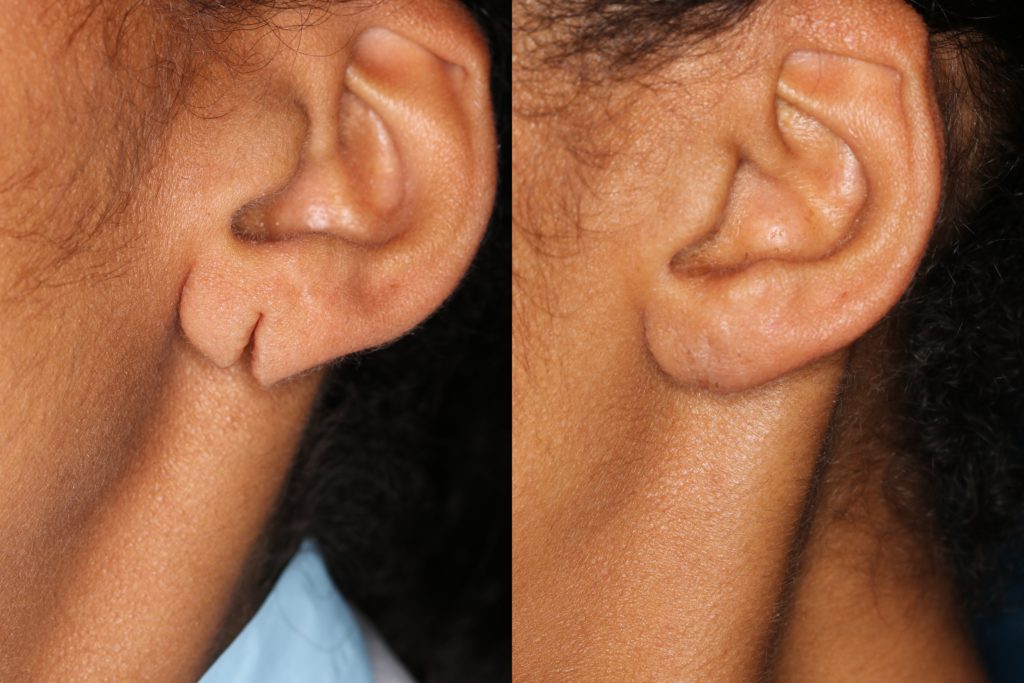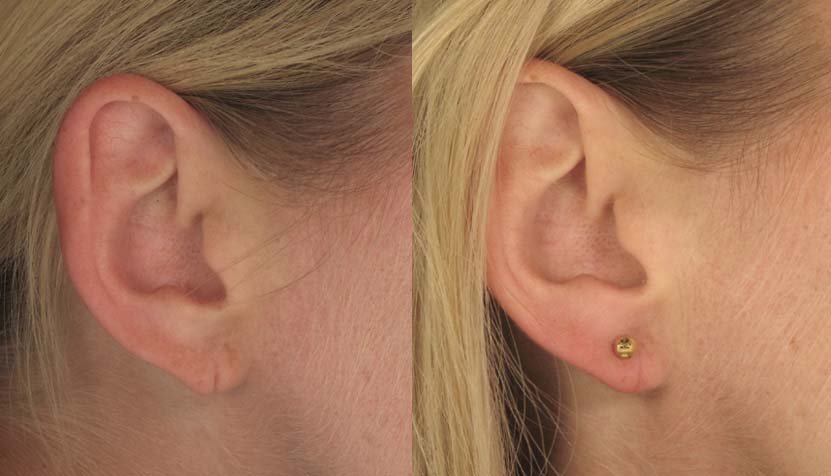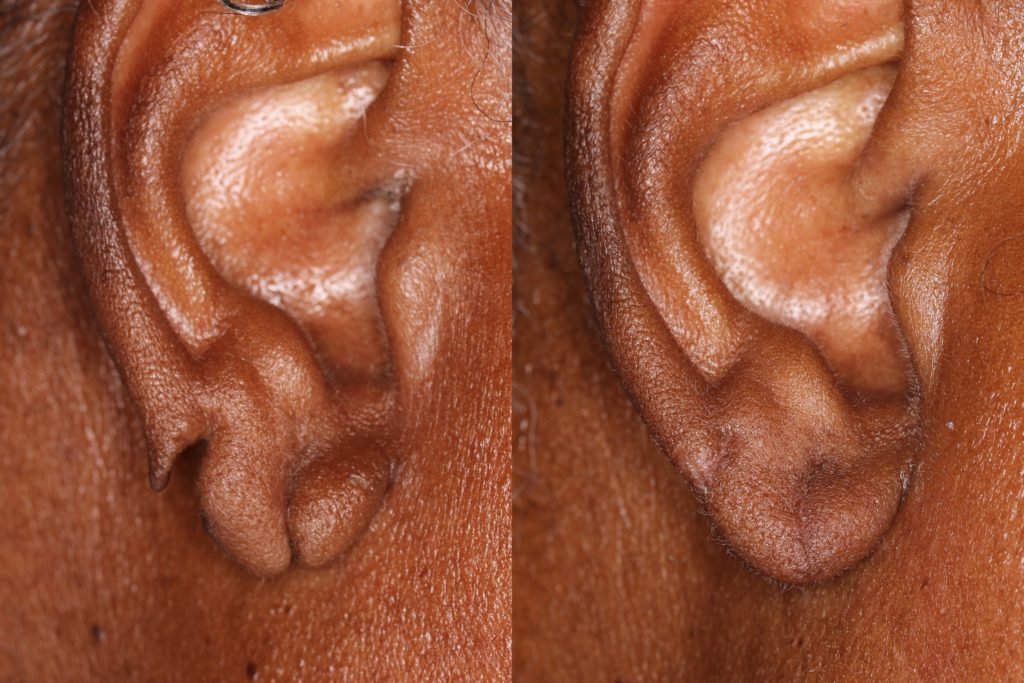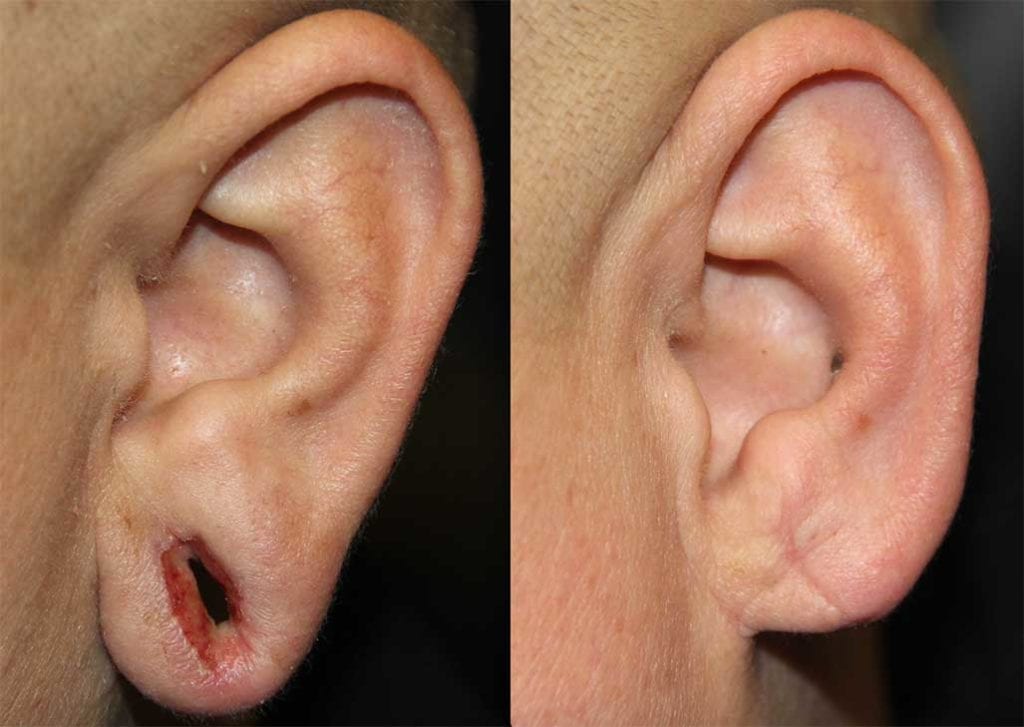Is earlobe repair covered by insurance? This question often arises for individuals who have experienced torn or damaged earlobes, seeking to restore their appearance and functionality. Earlobe repair, a surgical procedure to mend torn or damaged earlobes, can be a significant investment, prompting many to wonder if insurance will cover the costs.
Understanding the factors that influence insurance coverage for earlobe repair is crucial for individuals considering this procedure.
The answer to this question hinges on several factors, including the nature of the damage, the medical necessity of the repair, and the specific insurance policy. While some insurance plans might cover earlobe repair deemed medically necessary, others may consider it cosmetic and therefore not covered.
This article delves into the intricacies of insurance coverage for earlobe repair, exploring the factors that influence coverage decisions, alternative treatment options, and the importance of finding a qualified provider.
Earlobe Repair

Earlobe repair, also known as earlobe reconstruction, is a surgical procedure that restores the shape and appearance of a torn or damaged earlobe. It is a common cosmetic procedure that can address various earlobe issues, ranging from small tears to significant deformities.
Earlobe Repair Procedure
Earlobe repair surgery is typically performed under local anesthesia, making it a relatively painless procedure. The surgeon will first clean the area and numb the earlobe. Then, depending on the severity of the tear, the surgeon may use sutures, grafts, or a combination of both to repair the earlobe.
- Sutures:For small tears, the surgeon may simply use sutures to close the gap in the earlobe. The sutures are usually placed on the inside of the earlobe to minimize scarring.
- Grafting:For larger tears or when there is significant tissue loss, the surgeon may need to use a graft. A graft is a piece of skin taken from another area of the body, such as the back of the ear or the inside of the arm, and used to repair the damaged earlobe.
- Combination:In some cases, the surgeon may use a combination of sutures and grafting to repair the earlobe.
Causes of Earlobe Tears and Damage
Earlobe tears and damage can occur due to various factors, including:
- Heavy earrings:Wearing heavy earrings, especially over extended periods, can put significant stress on the earlobes, leading to tears or stretching.
- Trauma:Accidents, injuries, or even rough play can cause earlobe tears.
- Piercings:Repeated ear piercings or improperly placed piercings can damage the earlobe.
- Age:As we age, the skin on our earlobes can become thinner and more prone to tearing.
Types of Earlobe Repairs
Earlobe repair techniques vary depending on the severity of the tear or damage. Some common types of earlobe repairs include:
- Simple repair:This technique involves using sutures to close a small tear in the earlobe. It is often used for tears that are less than half an inch long.
- Grafting:This technique involves using a piece of skin from another area of the body to repair a larger tear or a damaged earlobe. The graft is usually taken from the back of the ear or the inside of the arm.
- Reconstruction:This technique involves using a flap of skin from the earlobe itself to repair a large tear or a damaged earlobe. This technique is often used for earlobes that have been severely stretched or torn.
Insurance Coverage
Insurance coverage for earlobe repair can vary depending on several factors, including the reason for the repair, the type of procedure, and the specific insurance plan. It’s important to understand the role of medical necessity in insurance coverage and how pre-existing conditions might affect coverage.
Additionally, comparing insurance policies from different providers can help you determine the best coverage for your needs.
Medical Necessity
Insurance companies typically cover medical procedures deemed medically necessary. This means the procedure must be required to diagnose or treat a medical condition, prevent further complications, or improve a patient’s health. Earlobe repair is often considered medically necessary when it’s performed to correct a tear or injury that impairs the ear’s function, such as hearing or balance.
However, cosmetic repairs, such as those done to enhance appearance, are generally not covered by insurance.
Pre-Existing Conditions, Is earlobe repair covered by insurance
Pre-existing conditions can impact insurance coverage for earlobe repair. If the earlobe repair is related to a pre-existing condition, such as a chronic skin condition or a prior injury, the insurance company may require documentation from your doctor to support the medical necessity of the procedure.
Some insurance plans may have limitations or exclusions for specific pre-existing conditions, so it’s crucial to review your policy carefully.
Insurance Policy Comparisons
Insurance policies from different providers can vary significantly in their coverage for earlobe repair. Some plans may cover the procedure entirely, while others may require a co-pay or deductible. It’s important to compare policies from different providers to determine the best coverage for your specific needs.
Factors to consider include:
- Co-pay or deductible:This is the amount you pay out-of-pocket for the procedure.
- Coverage limits:Some plans may have a maximum amount they will pay for earlobe repair.
- Network restrictions:Some plans may only cover procedures performed by in-network providers.
- Pre-authorization requirements:Some plans may require pre-authorization from your doctor before covering the procedure.
It’s essential to contact your insurance provider directly to inquire about their coverage for earlobe repair. They can provide you with specific information about your plan’s coverage and any applicable limitations or exclusions.
Cost and Alternatives

The cost of earlobe repair surgery can vary depending on several factors, including the severity of the tear, the surgeon’s experience, and the location of the surgery. However, it’s important to understand that insurance coverage for this procedure can be limited, and you may need to pay out-of-pocket for a portion or the entire cost.
This section will discuss the typical cost of earlobe repair surgery and explore alternative treatments for earlobe tears and damage. It will also compare the costs and effectiveness of different treatment options, providing you with a comprehensive understanding of your choices.
Cost of Earlobe Repair Surgery
The typical cost of earlobe repair surgery in the United States can range from $500 to $2,000 or more. This price range can fluctuate depending on the factors mentioned above. For example, a simple repair for a small tear might cost around $500, while a more complex repair for a larger tear or one involving multiple tears might cost upwards of $2,000.
Alternative Treatments for Earlobe Tears and Damage
In some cases, surgical repair may not be necessary, and alternative treatments can effectively address earlobe tears and damage. These alternatives can be more cost-effective and less invasive than surgery.
Non-Surgical Options
- Earlobe Adhesive:This option involves applying a strong adhesive to the torn earlobe, effectively holding the edges together and promoting healing. This method is generally suitable for minor tears and can be a cost-effective alternative to surgery.
- Earlobe Jewelry:Wearing a specific type of earring, such as a heavier or larger stud, can help to support the torn earlobe and encourage healing. This method is often used in conjunction with other treatments, such as adhesive.
- Earlobe Compression:Applying gentle pressure to the torn earlobe can help to reduce swelling and promote healing. This method is often used in combination with other treatments, such as adhesive or jewelry.
Finding a Qualified Provider: Is Earlobe Repair Covered By Insurance
Earlobe repair is a surgical procedure, and choosing the right surgeon is crucial for a successful outcome and minimal complications. The expertise and qualifications of the surgeon directly impact the quality of the repair and the overall patient experience.
Choosing a Qualified Surgeon
To find a reputable and experienced earlobe repair surgeon, patients should consider the following:
- Board Certification:Look for surgeons who are board-certified by the American Board of Plastic Surgery (ABPS) or the American Board of Otolaryngology-Head and Neck Surgery (ABOHNS). This certification ensures the surgeon has met rigorous standards of education, training, and experience.
- Specialization in Facial Plastic Surgery:While general plastic surgeons can perform earlobe repair, surgeons specializing in facial plastic surgery have extensive knowledge and experience in this specific area.
- Experience with Earlobe Repair:Inquire about the surgeon’s experience with earlobe repair procedures. Ask about the number of earlobe repairs they have performed and their specific techniques.
- Reputation and Patient Reviews:Research the surgeon’s reputation by reading online reviews, checking patient testimonials, and contacting previous patients if possible.
Asking the Right Questions
Once you have identified a few potential surgeons, schedule consultations to ask important questions:
- Explain the surgeon’s approach to earlobe repair:Discuss the techniques used, the type of anesthesia, and the expected recovery time.
- Inquire about the surgeon’s experience with your specific type of earlobe tear:Explain the nature of your tear, and ask if the surgeon has experience treating similar cases.
- Discuss potential risks and complications:Understand the potential risks and complications associated with earlobe repair, and how the surgeon manages these.
- Review before and after photos of earlobe repair:Request to see examples of the surgeon’s previous earlobe repair results.
- Ask about the cost of the procedure:Discuss the total cost of the procedure, including fees for anesthesia, facility, and follow-up appointments.
- Clarify payment options:Inquire about insurance coverage and payment options, including financing plans if necessary.
Recovery and Aftercare

Earlobe repair surgery is generally a minimally invasive procedure with a relatively quick recovery time. However, proper aftercare is essential for optimal healing and minimizing complications.
Recovery Process
The recovery process after earlobe repair surgery typically involves a few stages:
- Immediately after surgery:You will likely have a bandage or dressing over the repair site. You may experience some discomfort, swelling, and bruising. Your doctor will provide instructions on how to care for the wound and manage any pain.
- First few days:You will need to keep the repair site clean and dry. You may need to apply antibiotic ointment and change the dressing as instructed by your doctor. You should avoid strenuous activities and contact sports for a few days.
- First week:Most of the swelling and bruising will subside. You can start to resume normal activities, but you should still avoid strenuous activities and contact sports. You may need to continue applying antibiotic ointment and changing the dressing as instructed by your doctor.
- Second week:The repair site will continue to heal. You can start to resume more strenuous activities, but you should still avoid contact sports for a few weeks. You may need to continue applying antibiotic ointment and changing the dressing as instructed by your doctor.
- Following weeks:The repair site will continue to heal and strengthen. You can gradually resume all normal activities, including contact sports. You should avoid wearing heavy earrings for a few weeks after the procedure.
Potential Complications and Risks
While earlobe repair surgery is generally safe, potential complications and risks include:
- Infection:As with any surgical procedure, there is a risk of infection. This can be minimized by following your doctor’s instructions for wound care.
- Bleeding:Some bleeding is normal after surgery, but excessive bleeding can occur. This can usually be controlled with pressure, but may require additional treatment.
- Scarring:All surgical procedures result in some scarring. The amount and appearance of scarring can vary depending on individual factors, such as skin type and the size of the repair.
- Asymmetry:In some cases, the repaired earlobe may not be perfectly symmetrical with the other earlobe.
- Numbness:Some patients may experience temporary numbness around the repair site. This is usually temporary and resolves on its own.
Post-Operative Care and Follow-Up Appointments
Following your doctor’s instructions for post-operative care is essential for optimal healing and minimizing complications. Here are some general guidelines:
- Keep the repair site clean and dry:Gently wash the repair site with mild soap and water as instructed by your doctor. Avoid submerging the repair site in water for a few days after surgery.
- Apply antibiotic ointment:Your doctor may recommend applying antibiotic ointment to the repair site to prevent infection.
- Change the dressing:Your doctor will provide instructions on how to change the dressing. You may need to change the dressing several times a day initially, and then less frequently as the wound heals.
- Avoid strenuous activities and contact sports:You should avoid strenuous activities and contact sports for a few weeks after surgery. This will help to prevent the repair site from being disturbed and allow it to heal properly.
- Avoid wearing heavy earrings:You should avoid wearing heavy earrings for a few weeks after surgery. This will help to prevent the repair site from being pulled or stretched.
- Follow-up appointments:Your doctor will schedule follow-up appointments to monitor the healing process. You should attend all scheduled appointments.
Ending Remarks

Ultimately, whether or not earlobe repair is covered by insurance depends on a multitude of factors, including the individual’s insurance policy, the severity of the damage, and the medical necessity of the repair. While some insurance plans might cover earlobe repair, others may not.
By understanding the factors that influence coverage decisions, individuals can navigate the process of seeking insurance coverage for earlobe repair with greater clarity and confidence. Remember to consult with your insurance provider and a qualified healthcare professional to determine the best course of action for your specific situation.
FAQ Corner
What are the most common causes of earlobe tears?
Earlobe tears can occur due to various factors, including heavy earrings, accidental snags, and trauma. Heavy earrings can put excessive strain on the earlobes, leading to tears over time. Accidental snags on clothing or other objects can also cause tears, as can injuries resulting from sports or other activities.
Is there a way to repair a torn earlobe without surgery?
While surgery is the most common method for earlobe repair, some non-surgical options exist, such as using medical-grade adhesive or sutures. However, the effectiveness of these methods may vary depending on the severity of the tear.
What are the risks associated with earlobe repair surgery?
As with any surgical procedure, earlobe repair carries some risks, including infection, scarring, and asymmetry. However, these risks are generally minimal when performed by a qualified surgeon.
How long does it take to recover from earlobe repair surgery?
Recovery time for earlobe repair surgery is typically short, with most individuals able to return to their normal activities within a few days. However, it’s important to follow your surgeon’s instructions carefully to ensure proper healing.